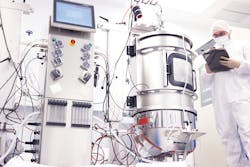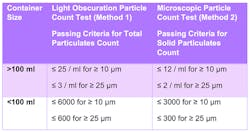Silicone tubing in biopharmaceutical processing
The rapid growth of single-use systems (SUS) in the biopharmaceutical industry has led to a massive effort among government and industry groups to establish uniform standardization for material integrity and purity for tubing and other components. While the U.S. Food and Drug Administration (FDA) takes its customary slow-but-sure approach, industry groups such as ASTM International, the U.S. Pharmacopeia (USP) and the American Society of Mechanical Engineers: Bioprocessing Equipment (ASME BPE) are working on new standards and updates regarding testing for particulates, bioburden, bacterial endotoxins, extractables and overall integrity. In addition, a joint team of subject-matter experts from the BioPhorum Operations Group (BPOG) and the Bio-Process Systems Alliance (BPSA) has developed a single-use toolkit to support SUS design, qualification and communication of the requirements between suppliers and end users.
There are many advantages responsible for the growth of SUS — flexibility, reliability, sustainability, lower capital and operational costs and higher product yield — but many believe that the biggest single advantage is the absence of cleaning and cleaning validation that is so critical to the operation of traditional stainless-steel tubing systems. SUS makes it possible to create sterile, closed systems with ready-to-use or gamma-sterilized components that can fit into a diversity of facilities and enable faster implementation and manufacturing times.
Increased reliance on supplier testing and data
While government and industry groups seek to establish solutions for standardized components, the biopharma industry is challenging SUS component suppliers to generate more standardized data based on existing industry-driven protocols. With regard to SUS tubing used in both research and development (R&D) and manufacturing, biopharmaceutical companies are especially interested in assurance related to contamination from particulates, bioburden and bacterial endotoxins. The bottom line is that biopharmaceutical manufacturers require components that are ready for use "out of the box."
To ensure Dow silicone tubing meets the requirements it has set, purity testing is conducted on a yearly basis and relevant data is shared with customers. This testing relates to the endotoxins, particulates and bioburden characteristics of silicone tubing to provide proof of cleanliness and ensure protection against contamination. Before reviewing the test results, a summary of the chemistry involved in making silicone tubing is useful.
Silicone: The material of choice for purity
Silicones are one of the most extensively tested materials used in healthcare applications, dating back to the 1950s. The advantages of Pt-catalyzed silicone tubing include its inherent purity, flexibility and ease of sterilization. In addition, silicone materials are inert and biocompatible, with no adverse effects on human health. Resilience, as well as kink and pressure resistance, are also major benefits of silicone tubing and make it an excellent choice for pharma and biopharma processing. Categorized as thermoset materials, silicones are stable under a wide range of temperatures, from minus 80°C to at least 215°C. This class of silicones are not sensitizing, pyrogenic, genotoxic, cytotoxic or hemolytic, and they exceed USP {88} Class VI tests.
Rendering silicone polymers into silicone tubing requires a cross-linking reaction. The DOW CORNING brand Pharma Tubing products are made with a platinum-catalyzed process involving a two-part system consisting of a vinyl-functionalized siloxane polymer base, siloxane crosslinker containing Si-H functionality, silica filler and the platinum catalyst (see Figure 1).
Figure 1. Platinum-catalyzed addition cure. Courtesy of Dow Silicones
This process requires no processing aids, no organic plasticizers and no stabilizers. Only a low level of catalyst is used, and there is no formation of byproducts. As no organic additives are introduced into the formulation and no byproduct is formed, the extractables profile is predictable and consists primarily of low levels of low molecular weight oligomers originating from the silicone polymers.
Drug manufacturers recognize the inherent purity of silicone, which explains why silicone tubing has become the material of choice for the most critical part of the drug-making process — the final filtration step before packaging. At this stage, tubing is in contact with the final drug product, and manufacturers want to avoid any deleterious impact due to impure components.
Testing for silicone tubing purity
To provide biopharma customers with reliable purity data on Dow’s Pharma brand of silicone tubing during the industry’s SUS standardization transition, the company developed test methods for subvisible particulates, bacterial endotoxins and bioburden aligned with the following established standards:
- United States Pharmacopeia (USP) {788} Particulate Matterin Injections
- USP {85} Bacterial Endotoxins Test
- ISO 11737-1 Sterilization of Medical Devices, Microbiological Methods, Part 1: Determination of a population of microorganisms on products
A more comprehensive description of these tests can be found at dow.com.
Subvisible particulates testing
Particulates of all sizes are of interest to regulators and producers of pharmaceutical products, and industry has tried to determine particulate distributions per USP {788}. Minimizing and controlling the risk of particulates is critical in biopharmaceutical processes downstream of the final filtration step —where the drug product is sterile and must not be contaminated — or for aseptic processes where filtration cannot occur. Particulate matter may affect drug purity, safety and efficacy and may cause thrombosis and embolization in patients.
The USP {788} Particulate Matter in Injections originally intended for packaged drug products is now also being applied to single-use components and systems in pharmaceutical processing. This USP chapter describes two counting techniques for enumerating particles: Method 1 — Light Obscuration Particle Count Test and Method 2 — Microscopic Particle Count Test (see Table 1).
Table 1. USP {788} Particulate Matter in Injections
Dow worked with an independent laboratory to conduct particulate count tests following a jointly developed test method following Method 2 of USP {788}. Results showed the particulate count for DOW CORNING brand Pharma Tubing products were well below the USP {788} criteria for the Microscopic Particle Count Test. The average particulates count for larger than 10 µm in size was less than 0.3 particulate/ml. For larger than 25 µm, the count was less than 0.15 particulate/ml.
Bacterial endotoxins testing
Endotoxins are defined as a pyrogen component of the lipid polysaccharide layer of gram negative bacterial cell walls. The most commonly applied standard for bacterial endotoxins testing is USP {85}, which includes three methods for detecting bacterial endotoxins:
- Gel clot detection of endotoxins based on clotting of the LAL reagent in the presence of endotoxins
- The turbidimetric technique based on the development of turbidity
- Chromogenic techniques based on the development of color
The bacterial endotoxin testing was performed following the gel-clot technique at Dow’s quality assurance laboratory under the following pass/fail criteria:
- Pass if there was no gel formation: the LAL reagent did not react/clot with extract that has <0.125 EU/ml
- Fail if there was gel formation: the LAL reagent did react/clot with extract with ≥0.125 EU/ml
Dow Silicones’ acceptance criteria was more stringent than the acceptance criteria of the USP {161} standard developed for medical devices — a bacterial endotoxin limit to 0.5 EU/mL, or 20 EU/device for products that directly or indirectly contact the cardiovascular system and lymphatic system. It tested multiple batches of all products within its DOW CORNING Pharma Tubing brand family, and all passed the stringent acceptance criteria of <0.125 EU/ml.
Bioburden testing
ISO 11737-1 states that: "Bioburden is the sum of the microbial contributions from a number of sources, including raw materials, manufacturing of components, assembly processes, manufacturing environment, assembly/manufacturing aids (e.g., compressed gases, water and lubricants), cleaning processes and packaging of finished product."
This standard suggests various methods for the removal of the microorganisms before counting them from the collection sample. Dow Silicones worked with an independent laboratory expert in bioburden testing to select and validate a method to verify the ability to adequately remove the microorganisms from the test product.
Once this method was validated, testing was conducted by filling the tubing samples with the selected eluent, membrane-filtering the eluent, incubating the filter and lastly, counting the microorganisms. The most complete total bioburden testing in ISO 11737-1 includes aerobic bacteria, yeast, mold and spores. Dow Silicones selected this protocol for testing the bioburden level on the silicone tubing surface in order to ensure the most comprehensive results.
No bioburden of any kind was detected in any of the DOW CORNING brand Pharma Tubing products.
Partnering with tubing suppliers
As the biopharmaceutical industry continues working toward new purity standards for SUS components, including tubing, manufacturers should select their suppliers carefully. Close collaboration with tubing suppliers is beneficial for ensuring purity and regulatory compliance.
As a guideline, leading tubing suppliers, whether their products are made from silicone, thermoplastics or stainless steel, are expected to:
- Maintain dedicated healthcare manufacturing facilities that are registered with appropriate government agencies that conduct periodic audits, such as the FDA.
- Demonstrate that they strictly adhere to the current good manufacturing practices as defined by the FDA.
- Operate in accordance with a robust quality management system, such as the ISO-9001 Quality Management System global standard.
- Manufacture and test their materials to ensure they comply with regulatory requirements in several different countries. This is critical for drug makers who plan to sell biopharmaceuticals in more than one country.
- Provide comprehensive documentation of the traceability of their raw materials. The more vertically integrated a supplier is, the better they are able to maintain documented traceability, change control, quality control and reliability of supply.
- Provide comprehensive, routine data demonstrating the purity of their products.
- Have a team of product safety and regulatory compliance experts that can help biopharmaceutical customers navigate the changing global regulatory landscape.
- Have a proven, long-term track record of supplying high-quality, high-purity tubing for healthcare applications.
Toward a standardized SUS future
The advantages of biopharmaceutical SUS for R&D and continuous manufacturing will continue to drive growth and make it the prevailing system. In the next few years, government and industry will develop and codify uniform standards of purity for SUS components used in biopharmaceutical manufacturing. Until those standards are adopted, component manufacturers must shoulder the responsibility of ensuring the purity of its materials. Meanwhile, biopharmaceutical manufacturers can follow the selection criteria outlined here for choosing supplier partners capable of helping them mitigate the risks of manufacturing a range of products using tubing and other types of healthcare production equipment.
Jennifer Gemo leads the biopharma processing business for Dow medical solutions at Dow Silicones Corporation. Based in Belgium, Gemo is responsible for building the five-year strategy for biopharma processing and implementing an innovation-driven investment plan. She joined Dow Corning in 2011 as a regional and then global marketing manager for the solar business innovation unit. Before joining Dow Corning, Gemo worked in Paris, France, at Ducker Worldwide. As an associate partner, she was in charge of key account and project management for leading chemical, packaging and construction materials players. Gemo holds a master’s of business administration from Institut Commercial de Nancy (France).
Lise Tan-Sien-Hee has a technical service and development role at Dow Silicones Belgium S.P.R.L., providing application expertise to customers and distributors in the biopharmaceutical and medical device market with a focus on single-use systems and components in the biomanufacturing process. Tan-Sien-Hee joined Dow Corning in 1995 as a regulatory compliance specialist for chemicals registration in Europe. In 2000, she joined the Dow Corning healthcare business as a regulatory affairs specialist for the biopharmaceutical and medical device markets, where she managed the regulatory files on silicone materials used as active pharmaceutical ingredients, excipients, biomaterials and tubing and supported customers’ products registration with the competent authorities. Tan-Sien-Hee holds a Ph.D. in chemistry from the Université Libre de Bruxelles (U.L.B.) Belgium.
Csilla Kollar serves as a technical service and development (TS&D) scientist at Dow Silicones Corporation for silicone products manufactured for the pharma and biopharma processing industries. Kollar joined Dow Corning in 1998 and has worked in technical roles within technology platforms and product development. Prior to her current role, Kollar gained expertise in filler surface modification technologies and silicone rubber formulations. She has 19 granted U.S. patents and has co-authored 53 internal Dow Corning Technical Information Reports and eight external publications. Kollar has presented at technical conferences and is a member of ASME-BPE, BPSA, BPOG and ASTM task groups. She holds a Master of Science in chemical engineering from Budapest University of Technology and Economics.







